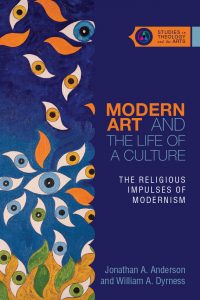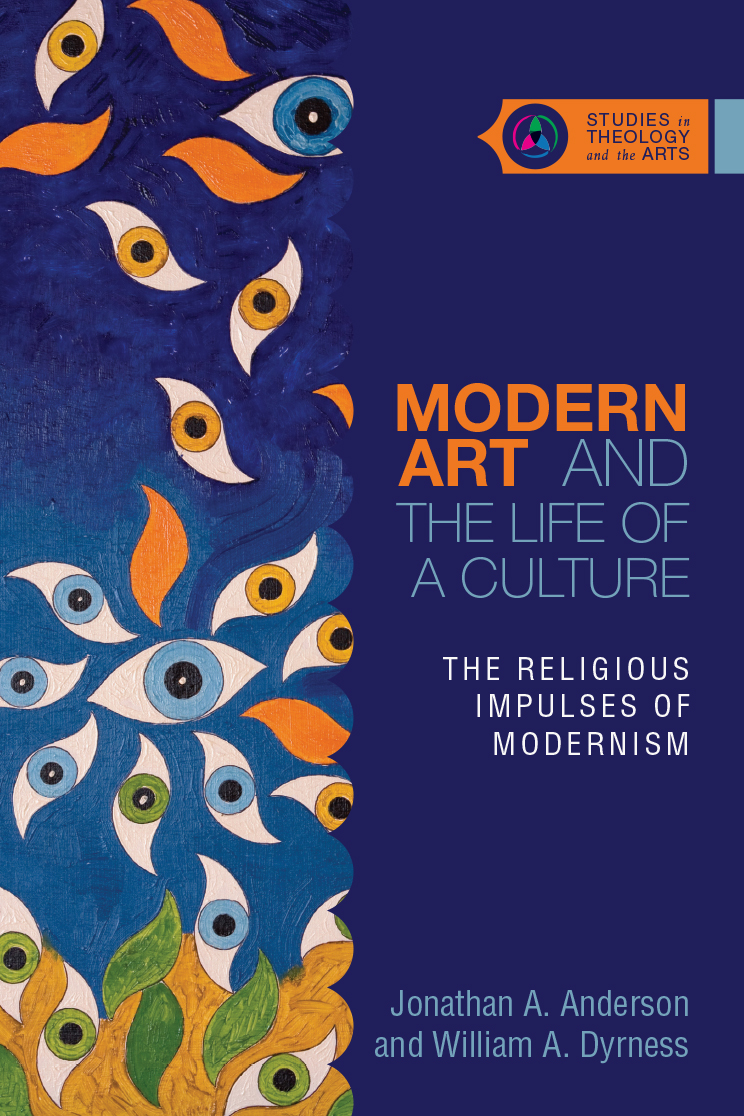Anderson, Jonathan A., and William A. Dyrness. Modern Art and the Life of a Culture: The Religious Impulses of Modernism. Downers Grove, IL: IVP Academic, 2016, pp. 374, $24, paperback.
 An Associate Professor of Art at Biola University, Jonathan A. Anderson is himself an artist and art critic. He has also afforded his artistic sensibilities to theological conversations, having coauthored the book Renewing Christian Theology: Systematics for a Global Christianity (Baylor University Press, 2014). William A. Dyrness is a respected scholar in the field of theology and the arts and has authored several books, including Visual Faith: Art, Theology, and Worship in Dialogue (Baker Academic, 2001), Reformed Theology and Visual Culture: The Protestant Imagination from Calvin to Edwards (Cambridge University Press, 2004), and Poetic Theology: God and the Poetics of Everyday Life (Eerdmans, 2011). Additionally, he is Fuller Theological Seminary’s Professor of Theology and Culture. In Modern Art and the Life of a Culture, Anderson and Dyrness have combined their expertise to provide a treatment of modern art that is historically accurate, aesthetically conscientious, and theologically grounded.
An Associate Professor of Art at Biola University, Jonathan A. Anderson is himself an artist and art critic. He has also afforded his artistic sensibilities to theological conversations, having coauthored the book Renewing Christian Theology: Systematics for a Global Christianity (Baylor University Press, 2014). William A. Dyrness is a respected scholar in the field of theology and the arts and has authored several books, including Visual Faith: Art, Theology, and Worship in Dialogue (Baker Academic, 2001), Reformed Theology and Visual Culture: The Protestant Imagination from Calvin to Edwards (Cambridge University Press, 2004), and Poetic Theology: God and the Poetics of Everyday Life (Eerdmans, 2011). Additionally, he is Fuller Theological Seminary’s Professor of Theology and Culture. In Modern Art and the Life of a Culture, Anderson and Dyrness have combined their expertise to provide a treatment of modern art that is historically accurate, aesthetically conscientious, and theologically grounded.
Anderson and Dyrness wrote Modern Art and the Life of a Culture as a response to Hans Rookmaaker’s influential book Modern Art and the Death of a Culture (InterVarsity Press, 1970), which has long served as a guide to culture and the arts for many evangelical Christians (pp. 9, 44). While the authors respected Rookmaaker’s influence and insight (p. 69), they ultimately rejected Rookmaaker’s suggestion that modern art predominantly sought to subvert religious belief; they argued instead that Christianity “continued to influence and constructively shape the development of the modernist avant-garde” and that “modernist artists were attempting to come to terms with (the meanings of) life in the age of modernity” (p. 10; see also p. 29). Thus, the authors contended that modern art—even that which is hostile toward organized religion—is profoundly spiritual and theological (pp. 41, 47). However, while Anderson and Dyrness sought to substantiate the important role of theology in modernism, they also avoided “Christianizing” art history to fit their narrative (p. 46), making clear that “to claim that religious traditions are alive and well in modern art would be claiming too much” (p. 41). Moreover, they acknowledged that “antagonism toward Christianity certainly had its influence on the rise of modern art” (p. 90). Even still, Anderson and Dyrness dismissed the widely accepted narrative that “religion played almost no constructive role at all in the development of modern art” (p. 18), and they meticulously chronicled the interplay of religion and modern art within European and North American contexts.
The high value of Modern Art and the Life of a Culture should be apparent. While commentators such as Rookmaaker and Francis Schaeffer have tended to view modern art as being hostile toward religion (and in some cases, rightfully so), Anderson and Dyrness have successfully shown the prominent role that Christian theology played in the development, subject matter, and style of modern art. For instance, the authors convincingly demonstrated that Catholic revivals in France in the nineteenth century had a major impact on modern artists, suggesting that modernism and religion are not necessarily mutually exclusive and that the “language of [modern] art [could] express Christian themes” (p. 136; see also pp. 90, 101). The authors also defended abstract art, viewing it not necessarily as a rejection of the created order (as is often charged in evangelical circles) but rather as a recognition of divine transcendence that surpasses reason and representation (p. 196; see also p. 182); indeed, the authors espoused that American Protestantism’s emphasis on personal experience and general revelation in nature “influenced the rise of abstract expressionism in North America” (p. 277).
Anderson and Dyrness brought credibility to their argument that theological questions played an important role in modern art by pointing to major figures within modernism, including Paul Gauguin, Vincent van Gogh, and Paul Cézanne (p. 44). Perhaps most interesting was the authors’ treatment of Andy Warhol, who is probably best known for his depictions of Campbell’s soup cans and of cultural icon Marilyn Monroe (pp. 314-15). While some critics have seen Warhol’s work as a sign of art’s demise, Anderson and Dyrness framed Warhol’s work within the context of his Byzantine Catholic faith (though, to say the least, elements of Warhol’s life and work would certainly seem to contradict that faith) (pp. 311, 314). As such, they interpreted Warhol’s paintings as modern day vanitas still-life works, which “emphasize the fragility and delicacy of the world” (p. 319). They further asserted that Warhol’s religious works (such as his Last Suppers), which on the surface may appear to be disrespectful to Christ/Christianity, are not “attacking religious belief but [are instead] ‘labeling’ one of the major modern obstacles to it [i.e., commercialism and consumerism]” (p. 324).
The breadth of scholarship in Modern Art and the Life of a Culture is tremendous. However, the book could have been further enriched by some reference to non-Western art. But because the book is largely a response to Rookmaaker, who dealt mostly with European and American art, this omission is forgivable to an extent. The authors themselves acknowledged this intentional limitation for the purposes of this book (pp. 12-13, 45), and they did include in their discussion some important and notable minority artists, such as Henry Ossawa Tanner (pp. 258-61). Still, their exclusion of non-Western voices unnecessarily opens the authors up to criticism from the very artistic and academic circles with whom they are seeking to engage with this book. Moreover, if, as the authors admitted, “a variety of non-Western modernisms . . . have even stronger threads of religious and theological content [than those in the West]” (p. 45), the inclusion of non-European and non-American artists would have greatly bolstered the authors’ arguments and further substantiated their critique of Rookmaaker.
Rookmaaker’s book was important for its time, and Rookmaaker has greatly impacted a generation of evangelicals in regard to engagement with the arts. Anderson and Dyrness respected this contribution while also providing necessary rectification. They asserted that while evangelicals have tended to highlight the negative aspects of modern art (such as perceived hostility toward Christianity), believers have often ignored the positive components of Christian influence within modern art and the profoundly spiritual questions that arise within modernism. Therefore, this volume by Anderson and Dyrness is a crucial contribution to the field of theology and the arts and is highly recommended for students of this discipline. Students would also do well to read Peter Gay’s Modernism: The Lure of Heresy from Baudelaire to Beckett and Beyond (W. W. Norton & Company, 2008) and James Elkins’s On the Strange Place of Religion in Contemporary Art (Routledge, 2004) to round out their understanding of religion in relation to modern art.
Richard H. Stark, III
Berea First Baptist Church, Greenville, SC




